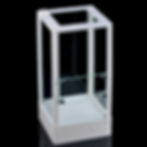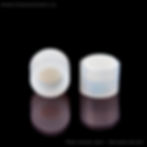Jumping Spider
Enclosures & Parts
The Arboreal Glass Towers: Features & Customizations

Our Arboreal Glass Towers are designed for pet jumping spiders, juvenile tarantulas, mantises, and other arboreal species that thrive in elevated environments. These enclosures combine unmatched visibility, precise airflow, and moisture control, ensuring your pet feels at home. Choose from four enclosure designs, each tailored to your pet's unique needs—whether for spiderlings, adults, or customizable setups.
-
Four Unique Designs: Options for spiderlings, adults, and customizable setups.
-
Stealthy Cross-Ventilation: Superior airflow design with discreetly integrated ventilation lines that maintain a sleek, glass-dominant look.
-
Crystal-Clear Visibility: Glass panels provide an unobstructed view of your pet, making every interaction enjoyable and immersive.
-
Effortless Access: Options for bottom, front, rear, and top openings, all magnetic parts, make feeding and cleaning easy.
-
Moisture Control: Substrate trays, stack-effect-driven ventilation, and specialized access ports make maintaining consistent humidity effortless, whether misting or attaching water ports.
-
Customizable Features: Modular, magnetic, and interchangeable components let you personalize your setup and upgrade easily.
In-Depth Review by a Fellow Keeper:
Glass enclosures resist scratches better than plastic enclosures. These products combine plastic PLA PRO structural and functional components, strong neodymium magnets, and arthropod-safe adhesives, leveraging a hybrid design that enhances functionality and enables precise, innovative features through advanced 3D printing.
If you're unsure which enclosure size is best for you, check out our "Enclosure Size Guidelines for Jumping Spiders." For more details on each product, click the links above. To understand the differences between all designs, continue reading below.

What is the difference between the arboreal towers:
The AeroVent, LightVent, CrystalVent, and ItsyVent arboreal towers each have unique features designed to cater to different species' ventilation and humidity management needs. While they all serve the primary function of providing a suitable habitat for arboreal pets, each model offers distinctive design elements. These towers are compatible with several accessories, allowing for various configuration possibilities to create the ideal environment for your pet.
Choosing the proper jumping spider enclosure is crucial for your pet's health and well-being. A well-designed enclosure ensures that your jumping spider has the appropriate space, ventilation, and humidity levels to thrive. The AeroVent, LightVent, and ItsyVent models offer innovative solutions tailored to the specific requirements of arboreal species. By selecting the right enclosure, you not only promote natural behaviors but also enhance your pet's overall quality of life. These models are excellent choices for any enthusiast looking to provide the best care for their jumping spider.


Ventilation and structure:
-
AeroVent: Includes additional ventilation lines across the side-bottom glass panels, enhancing cross-ventilation, essential when using a substrate tray directly.
-
LightVent: Features a slim, fully ventilated bottom plate, allowing full-length glass panels on three sides, maximizing visibility and airflow.
-
ItsyVent: Designed specifically for baby spiders and spiderlings, offering optimal moisture control with a well-ventilated structure that supports their growth.
-
CrystalVent: Glass panels on all five sides provide nearly 360° visibility while combining discreet ventilation for optimal airflow and moisture control without sacrificing aesthetics.
These enclosures have efficient ventilation mechanisms; the humid air rises from the bottom, promoting cross-ventilation through the stack-effect driven by the buoyancy of moist air (learn more in our "Enclosure Ventilation, Humidity & Temperature Guide").
Substrate Tray and Ventilation Plate Integration:
The AeroVent includes a magnetic substrate tray by default, while the LightVent includes a magentic ventilated bottom plate. These components are interchangeable:
-
The substrate tray can be purchased separately and used with the LightVent, adding a humidity buffer.
-
The ventilation plate can also be used with the AeroVent, providing additional airflow options.
The ventilation plate can be used at the bottom or the top of the enclosures, replacing the glass to add even more airflow. Combining the substrate tray with the ventilation plate allows for easy removal of the tray for watering or maintenance without fully opening the enclosure, leaving a false bottom. This setup can help fix objects to the bottom and protect the substrate from collecting organic material quickly.
The ItsyVent and CrystalVent setups have their own parts and accessories, which are not interchangeable with those of the LightVent or AeroVent due to different dimensions and design standards. The ItsyVent and CrystalVent enclosures comes with both a substrate tray and ventilation plate combined, providing excellent humidity and airflow control.

Species suitability and environmental adaptation:

-
The AeroVent is well-suited for species with high ventilation and humidity needs, ideal for environments with dry air. The buoyancy-driven stacking effect helps circulate moist air throughout the habitat as it evaporates from the substrate tray.
-
The LightVent is optimized for species that require significant airflow in properly acclimated rooms. Species that do not require substrate benefit from the added ventilation while keeping a clean, spacious bottom.
-
The ItsyVent is perfect for baby spiders and spiderlings, providing an environment that supports their specific growth needs with optimal moisture control.
-
The CrystalVent is a versatile all-rounder, ideal for a wide range of species. Combines classic design with superior visibility, airflow, and humidity control to meet diverse habitat needs.
Our eclosures provide unmatched flexibility and customization options, giving you professional-grade solutions engineered for different species' specific ventilation and humidity requirements.
Whether you need maximum airflow, optimal moisture control, or specialized nursery conditions, each tower grows with your pet's needs and your expertise as a keeper.
Ventilation, why lines instead of holes or mesh:
Traditionally, cross ventilation in acrylic jumping spider enclosures is achieved through holes or mesh on opposite sides, as drilling holes or installing mesh discs is more straightforward than creating precise thin lines. However, 3D printing technology makes crafting thin, long ventilation lines within intricate plastic parts feasible. Such lines provide excellent airflow and prevent escapes by spiderlings or fruit flies while avoiding the risks of leg or fang entrapment often associated with mesh in tarantula setups.
The big question is: do lines provide more ventilation? Yes, they do.

Let's break down the ventilation metrics for a standard 10x6 cm ventilated wall. The rear panel features ten vertical ventilation lines, each 9 cm long and averaging 0.45 mm in width, although we'll calculate using a maximum width of 0.5 mm for simplicity. Thus, the open area per line is calculated as 90 mm multiplied by 0.5 mm, giving 45 mm² per line. This results in a total of 450 mm² of open area across all ten lines.
For comparison, consider a typical small hole in an acrylic jumping spider enclosure measuring 1 mm in diameter. The area of each hole, calculated as Pi times the radius squared (radius being half of the diameter), gives approximately 0.79 mm² per hole. To provide a ventilation area equivalent to the ten lines, approximately 570 holes are needed, as calculated by dividing 450 mm² by 0.79 mm².
Additionally, the AeroVent edition incorporates three ventilation lines on the bottom of each side. The total area for these lines is calculated as 3 times 90 mm times 0.5 mm, equating to 135 mm² per side, equivalent to about 172 holes.
The Light Edition's ventilated bottom is equivalent to about 598 holes. This configuration also supports top ventilation if both the glass and ventilated top options are selected.
This calculation highlights the efficient design of our ventilation system, ensuring optimal airflow with minimal structural disruption. Furthermore, it provides a clear and pristine view through the undisturbed glass, enhancing visibility and aesthetics.
Cross ventilation happens when air enters one side of the structure and exits through the opposite furthest side, facilitating airflow throughout the habitable volume and preventing stagnant air. While ventilation through holes on two opposite sides can promote some air circulation, strategic placement of vents, especially at the top and bottom, is crucial. Our jumping spider enclosures maximize airflow efficiency with strategically placed thin ventilation lines, enhancing the overall environment for the inhabitants.

Differences with the Duo & Tri Glass Habitats:
Simple: The “Duo and Tri glass spider enclosures” are meant to use long-term or more significant substrates and do not have a removable bottom. They are meant for species that need substrate to burrow or catch prey. For example, many arboreal tarantulas require a substrate, even if they have arboreal behaviours.
The Duo & Tri glass product can be customized long, wide, or tall, with different proportions and many more size options than the towers. This is because there are many more terrestrial species with different needs than only arboreals. When made tall or with long proportions, the Duo & Tri glass habitats can also function as a pet jumping spider enclosure.
One key difference is that the arboreal glass towers utilize a bottom-to-top ventilation flow, while the duo and tri glass systems rely on air entering through one or two side walls and exiting through the top lid. The top lid features a ventilated rim and a removable glass section.
The arboreal glass towers have a removable bottom, which allows for more service access and allows for frequent cleaning of the bottom surface.

















